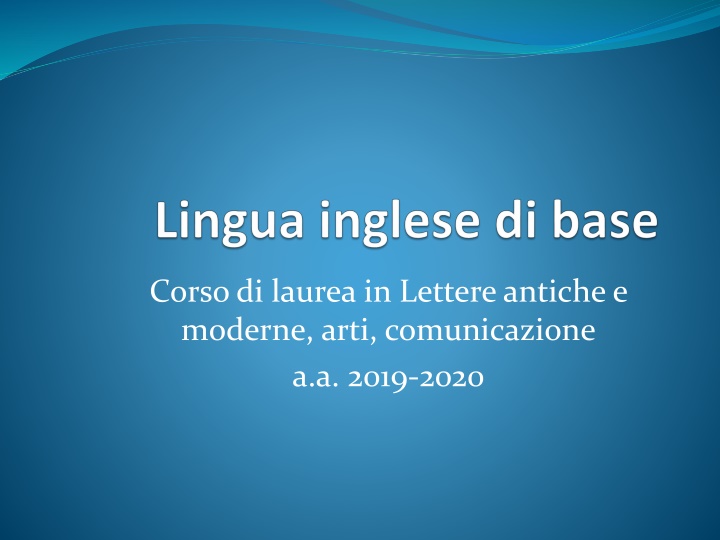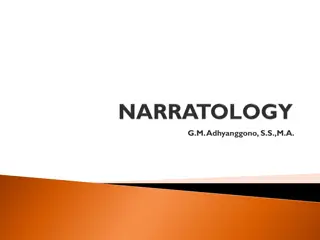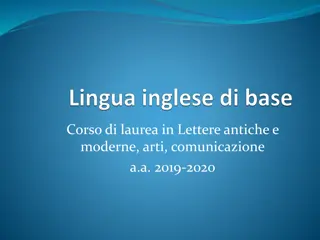
Exploring the Art of Storytelling: Narratology and the Creation of Stories
Dive into the fascinating world of narratology and storytelling as we explore the definition of a story, its various forms, and the intricate process of how stories are crafted. From understanding the principles of narrative representation to delving into the stages of story creation, this article sheds light on the complexity and creativity involved in the art of storytelling.
Download Presentation

Please find below an Image/Link to download the presentation.
The content on the website is provided AS IS for your information and personal use only. It may not be sold, licensed, or shared on other websites without obtaining consent from the author. If you encounter any issues during the download, it is possible that the publisher has removed the file from their server.
You are allowed to download the files provided on this website for personal or commercial use, subject to the condition that they are used lawfully. All files are the property of their respective owners.
The content on the website is provided AS IS for your information and personal use only. It may not be sold, licensed, or shared on other websites without obtaining consent from the author.
E N D
Presentation Transcript
Corso di laurea in Lettere antiche e moderne, arti, comunicazione a.a. 2019-2020
Narratology A short introduction Narratology is a humanities discipline dedicated to the study of the logic, principles, and practices of narrative representation. (Meister 2011)
Narratology A short introduction Narratological theorems play a central role in the exploration and modeling of our ability to produce and process narratives in a multitude of forms, media, contexts, and communicative practices. (Ibid.)
What is a story? A story is an account of a series of related events, experiences etc. that can be true (e.g. memoir, autobiography, biography) or fictitious (e.g. fairy tale, legend, novel). (Wikipedia)
What is a story? Stories are found in all forms of human creativity, art, and entertainment and can be grouped into: - non-fiction; - fictionalization of historical events; - fiction proper. (Ibid.)
How is a story told? Story-creationcan be described as a three stage process. Whatcharacters to include, whatactions they perform/undergo + whereand when theseactions will take place; 2) how to tell the story; 3) how to present the story concretely. 1) (Remael et al. 2015)
Stage 2 Authordecides on: order in which to present the actions (chronological vs non chronological, frequencyof the actionsetc.); 2) specificities of the characters (physical appearance, mental properties and behaviour); 3) spatio-temporal settings. 1) (Ibid.)
Stage 3 First two stages, story = abstractconstruct. Third stage, authordecides how to tell the story concretely uses different techniques to decide: - what to present; - how to show present. (Ibid.)
To sum up Story-creation is a highly complex process involving various stages and offering quasi endless possibilities when it comes to selecting and combining different elements. text analysis = analysis of content and style. (Ibid.)
Story-reconstruction Storiesare made to be read, listened toor watched byan audience. Audiences followa path that is opposite to the oneof the author. Story-reconstruction = universal process. (Ibid.)
Story-reconstruction Audiences reconstruct stories by creating mental models of who did what with and/or to whom, where, when and why. Actionsare central in the model and all otheraspects (characters and spatio-temporal settings) are related to them. (Ibid.)
Story-reconstruction As the story progresses, audiences continuously update their mental model of the story, adding new information to it, confirming what was already there or what they inferred, and changing existing information or assumptions based on information they have received later. (Ibid.)
Narratological building blocks Charactersand action Characters and theiractions move the story forward. In any narrative thereare usually: - focal character/s; - supporting characters; - background characters. (Ibid.)
Narratological building blocks Characters can be: - new/known; - used fortemporal orchestration; - linked toone another/toa particularsetting; - authentic/fictional; - real/unrealistic; - used to represent a group/idea/stereotype. (Ibid.)
Characterization Characters can be presented quicklyand straightforwardlyor gradually. Readers/viewers get to know characters through: - physical appearance; - actions/reactions; - what they sayand how theysay it. one- dimensional VS three-dimensional characters. (Ibid.)
Focalization Coined by Genette (1972) as a replacement for perspective and point of view . Selection of amounts of information that are accessible depending on a particular focalization. Focalization VS narrator. (Niederhoff 2011)
Spatio-temporal settings Oneof the basic narrative building blocks. There can be no action without a setting (timeand place). Importance and function of timeand setting may change throughout the story. Settings are linked toone another (chronologically VS flashback/flashforward) temporal orchestration. (Remael et al. 2015)
Spatio-temporal settings Settings can be: - global/local; - used as background/to serve a symbolic function; - real/imagined; - new/known; - presented explicitly/implicitly; - Familiar/unfamiliar; - related to specificcharacters. (Ibid.)
Genre Classification according to specific repetitive formal, aesthetic or narrative features. Examples: comedy, melodrama, sci-fi, horror, action Genre global strategies (author) + general expectations (audience). Hybrid categories: romantic comedy, sci-fi horror (Ibid.)
Genre Some pure genre films will also depict certain prototypical or even stereotypical character types, who represent specific personalities and patterns of behaviour. Examples: couple in love in romantic comedies, criminal VS detective in thrillers (Ibid.)
Different media, different languages Monomodal VS Multimodal texts 1) Novels, poems, paintings etc.: monomodal 2) Films, theatre plays, comics etc.: multimodal
Different media, different languages Monomodal VS Multimodal texts Each medium uses its own language or combination of languages to fulfil 4 main functions: - denotative function: showing what is important for the narrative; - expressive function: rendering a character s emotions or eliciting a mood or emotion in the audience; - symbolic function; - aesthetic function. - (Remael et al. 2015)
Different media, different languages Works of literature Only rely on (written) verbal language. images, actions, rhythm, characterisation are created through word choice (including figures of speech), syntax, focalization. Usuallydeeper psychological insight.
Different media, different languages Films Oral and writtenverbal language; images; sounds; music. - - - -
Different media, different languages Film language Combination of various film techniques thatcan be grouped into 3 categories: mise-en-sc ne; cinematography; editing. - - - (Remael et al. 2015)
Film language Mise-en-sc ne What is being filmed in a shot. Includes: setting, costume and makeup, staging. (Ibid.)
Film language Cinematography How shots are filmed. Comprises their photographic qualities, framing and duration. (Ibid.)
Film language Editing Relations between different shots. These include a graphic, rhythmic, spatial and temporal dimension. (Ibid.)
In conclusion Film languagedetermines the form in which the story is told. Film techniques show the audience what is important in an image, they can also guide or confound the viewer s expectations. They can be used to generate suspense or surprise and to elicit more longstanding moods in the audience (Ibid.)
A case study Stories with and about animals The animal He created to be Our base nature And our state of nature And our innocence And our memento mori on Earth. (The Seahorse Rears to Oblivion Current 93)
Myth, symbolism and the unconscious Humans haveoften felt the importance of animals in their exploration of what is beyond human understanding (cf. Carl Jung and Aniela Jaffe). Jung: all the fantastic associations that animals possessed in the past survive to this day, not only in the unconscious, but also in the realm of myth and symbolism. (Paravia 2007)
Myth, symbolism and the unconscious Jaffe: animal symbolism isvery important in any religion, whereanimal attributesare ascribed to supreme gods, or the gods themselvesare represented as animals. Cf. Hindu gods, Greek mythology, Christian symbolism. (Ibid.)
Myth, symbolism and the unconscious For some cultures (e.g. native Americans) there is no division between animal and human domains and the relationship between animals and humans is one of mutual aid and respect. (Ibid.)
Animal fables and satire In many traditions, the characters in fables are animals that behave like humans and are used to teach a clear moral lesson. Cf. fables by Aesop, Phaedrus, Horace. (Ibid.)
Animal fables and satire Preserved in the clerical schools of the medieval church, animal fables survived well into the Middle Ages. The animals portrayed in these stories mainly intended for communal entertainment by wandering ministrels have plenty of human vices and ingenuities and very few virtues. (Ibid.)
Animal fables and satire Satirists have often used animal characters to question the sanity of human behaviour particularly that of politicians. Cf. Gulliver s Travels and Animal Farm. (Ibid.)
Animal or symbol? Animal characters are often portrayed with an astonishing degree of emotional intensity and intimacy. In most of these stories, the big question is how to interpret animal images: when can they be read naturalistically and when do other, symbolic meanings come into play? Cf. The Rime of the Ancient Mariner and The Black Cat. (Ibid.)
References Remael etal. (eds), 2015. Pictures painted in words: ADLAB Audio Description guidelines. EUT Edizioni Universit di Trieste. Meister, J.C., 2011. Narratology. In The living handbook of narratology, https://www.lhn.unihamburg.de/node/48.html (last access 12.10.2019). Niederhoff, B., 2011. Focalization. In The living handbook of narratology, https://www.lhn.uni-hamburg.de/node/18.html (last access. 15.10.2019). Irvine, M., 2007. Of Men and Animals. Six Modernist Short Stories. Paravia Bruno Mondadori Editore. Genette, G. (1972). Narrative Discourse: An Essay in Method. Ithaca: Cornell UP. Wikipedia. Narrative. https://en.wikipedia.org/wiki/Narrative (last access 30.10.2019).



